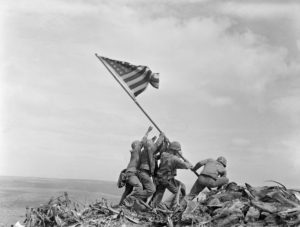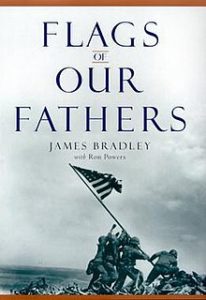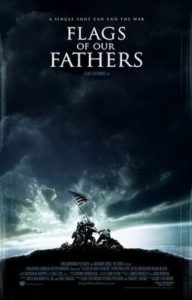All clickable links in red
Genre – War Movie (true story)
Time: 2 Hours, 12 minutes
Platform: Amazon Prime (on rent), You Tube Free
Every world event, be it social, political, technological, has a defining moment and defining image. The Berlin Wall being knocked down by ordinary people symbolized people power over Regimes. Closer home, Indian Army soldiers dancing atop a destroyed T-59 tank and General Niazi, signing the surrender defined the birth of Bangladesh and the outright victory of the Indian Armed Forces in the 1971 war.

The American experience in Vietnam was epitomized by the “naked Vietnamese girl,” while during WW2 the flag raising on Iwo Jima symbolized America’s victory over Japan,as Iwo was Japanese soil, and the impending conclusion of the war. Who were the US Marines who raised the flag on Mount Suribachi? Faceless soldiers, or did they have a life of their own? What was their story?

James Bradley’s book Flags of our Fathers explores this aspect, including the immigrant backgrounds of soldiers and their journey from Camp Pendleton in California, to Iwo Jima. The book also explored their lives after the event. Except for Bradley who settled down and raised a family, the others became drifters who struggled to integrate into society, much like other war veterans who experienced the brutality of war.
Given such an in-depth background in the book, Clint Eastwood rose to the occasion and directed one of the greatest war movies ever made. The flag raising and the event only serves as a metaphor for their subsequent battles.
The entire story, as in the book, is told through the eyes of medic, John ‘Doc’ Bradley (Ryan Philippe), James Bradley’s father and how as a ‘doc’ he saved lives in one of the toughest battles of the Pacific War. The Battle of Iwo Jima was the only one where American casualties were greater than Japanese and in the film, we get to see why. All natural features have been turned into bunkers or pillboxes, causing chaos for the advancing Marines who were caught off guard by the lack of fire on the landing beaches. Once they go inland, the Japanese firing from hidden bunkers and gun sites leads to horrific casualties. This is where ‘Doc’ Bradley comes into his own. The flag raising was on the third day of the Battle and only three of the original six men survived the event–a perfect metaphor for the casualty rate.
The War Department, later known as the Department of Defense, brings the trio back to the safety of the US Mainland and requests them to reenact the ‘storming of Iwo Jima’ in a stadium to boost War Bond sales. The ‘circus’ takes its toll on one of the surviving men, a Native American Ira Hayes (Adam Beach), who says “I won’t climb that damn mountain again; once is enough”. His reluctance is based on the initial horrific and graphic sequences of the battles, which take away from the usual bombast of propaganda and writers who say flowery stuff about ‘dying for the country’. This is war in its essence–brutal, animal, kill or be killed.
Bradley packs his experiences in a compartment and survives the war, but as his son says, he allowed none of the children to interact with the media on the anniversary of the Iwo Jima flag raising. Hayes’s story is the most tragic, as he can’t fit back into society and, combined with the socio-economic pressures on Native Americans, leads to his death in a bar fight. Rene Gagnon (Jess Bradford) experiments with different occupations but cannot excel in any.
The trauma is too deep for the survivors.
Bradley, Gagnon and Hayes acted as themselves in the final shots of he John Wayne epic , The Sands of Iwo Jima(1949) which was all about John Wayne , and how HE instructed the trio to raise the flag (yes – John Wayne can do that 🙂 )
The film doesn’t settle for a linear storytelling and cuts back and forth between the present and the past and at times, past within the past; yet it doesn’t lose the narrative. It also goes beyond the guns and glory angle and addresses the finer layers of experience and human conditions.
Eastwood’s direction is exceptional. The faceless guns and machine guns raining death on the Americans become a metaphor for the hidden Japanese who the Marines (and the audience) never see. It’s as if some faceless entity is orchestrating the Marines’ death, in the same way another faceless entity, the War Department, lays a parade (like a circus) for the surviving trio.
 By any measure, this is a Director’s film. Eastwood chooses to use the film as a metaphor for the overall war experience, rather than focusing solely on guts and glory. (It was said of the battle that Uncommon Valor was common in Iwo Jima) The men may have survived the killing, but the war is with them forever, inside their heads.
By any measure, this is a Director’s film. Eastwood chooses to use the film as a metaphor for the overall war experience, rather than focusing solely on guts and glory. (It was said of the battle that Uncommon Valor was common in Iwo Jima) The men may have survived the killing, but the war is with them forever, inside their heads.
A special mention about the CGI. Though operational WW2 tanks and planes existed in 2004-5 when the film was under production (and still exist in 2024), the replication of a large-scale amphibious operation is impossible because of the sheer numbers of ships and amphibious vehicles (Amtracs), used in the beach landings. Shooting in Iwo Jima is forbidden as it has been designated as a Japanese National shrine with visits allowed only by the ever-decreasing numbers of WW2 veterans on both sides. So, the CGI steps in and skillfully recreates the amphibious operation. Tiny details, such as the concussion waves on water when the big 16-inch guns of battleship fire, are replicated shown well. In addition, ‘Iwo Jima Island’, ‘Mount Suribachi’ where the flag was raised, B29 bombers ‘landing’ on Iwo Jima are ‘digitally created’.
This is a rare war film that shows both the ‘glory’ and its cost and the downward spiral of war trauma of war veterans.
Be warned; the initial battle scenes are very gory with flying body parts and other graphic violence; there is no other way to show the effects of war.
It’s one of rare ‘perfect’ war films that punches far above its weight.
Hats off and a salute to a true American director who shows both sides of the American Experience of War–the highs and the sorrow, and not the jingoistic glory.
It’s available on Amazon Prime on rent and is free on You Tube
Real History/ Historical Background – 5 out of 5
Script – 5 out of 5
Story – 5 out of 5
Direction – 5 out of 5
Photography – 5 out of 5
Special Effects – 5 out of 5
Total – 5 out of 5
Rammesh,
I have read many reviews of this film.. and your is the best.
A perfect mix of cinema analysis, military history, a succinct narrative of the brutality of a battle over a stark, unforgiving volcanic rock (but with two Japanese airfields), reference to one of the most famous photographs of war, and also the subsequent history of the four men. The tragic life of Ira Hayes after the war is worth reading at Wikipedia.
This was Clint Eastwood’s ‘finest hour’ as a director, in my opinion. And even more so, considering another aspect of the film, which, as far as I know, stands alone in film history. Perhaps you have more to say about that at a future date.
Best regards,
Robin
Thanks a lot ; your view says it all. The Other side of the Hill will be in the next blog, next sunday 🙂